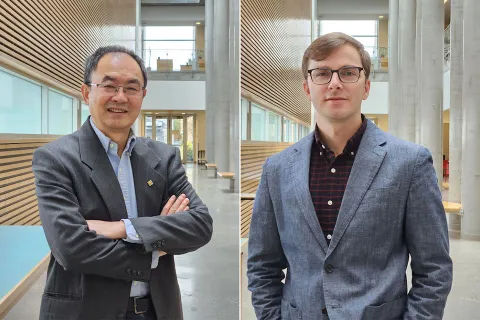From waste to want: Converting carbon dioxide to liquid fuels and carbon fibres

Is it possible to reduce greenhouse gas emissions while creating useful products? Researchers at the University of British Columbia's Faculty of Applied Science are tackling this challenge head-on.
A UBC engineering project to convert carbon dioxide into liquid fuels and solid carbon fibres is one of five research projects on high impact climate mitigation or adaptation solutions that has been awarded $180,000 from the Pacific Institute for Climate Solutions.
Over these next three years, UBC engineering researchers Drs. Chester Upham and Xiaotao (Tony) Bi will work to better understand and control a catalyst reaction that will capture the carbon needed to create these products. A pilot unit is planned for operation in the Clean Energy Research Centre at UBC.
Project partners include Exaer Carbon, Paper Excellence Canada and Catalyst Agri-Innovations Society.
“It’s an exciting way to convert carbon dioxide into useful products,” said Upham, an assistant professor of chemical and biological engineering, and principal investigator for the project.
“Instead of taking crude oil and converting it to gasoline, we're taking carbon dioxide and methane and converting it to gasoline, which we can then use instead of just releasing it into the atmosphere.”
The project’s other product — solid carbon fibres — is the foundation for countless everyday items, such as bike frames, aircraft wings, car components, and sports and medical equipment. “The benefits of making that carbon as a solid form is that it’s a saleable product, and you’re not making a product that will re-release captured carbon dioxide into the air,” Upham said.

Exaer Carbon will use their expertise in carbon upgrading to turn the carbon fibres produced at UBC into a commercially viable material.
“If you can really cost-effectively convert greenhouse gases into products of value, you’re creating this market for it that could potentially displace trillions of dollars’ worth of industry and billions of tonnes of greenhouse gas emissions globally,” said David Garfield, founder and CEO of Exaer Carbon. “You could change the entire materials paradigm.”
Paper Excellence Canada and Catalyst Agri-Innovations Society will assess the environmental impacts and economic performance of a technology and help plan the demonstration and piloting efforts.
“We are particularly interested in this technology because pulp and paper mills produce biogenic carbon dioxide when we burn bark and lignin to power our mills,” said Davis Chiu, director of innovation and acting head of carbon strategy for the Paper Excellence Group.
“This research provides a promising pathway to capture this carbon dioxide and use it to produce items of value. The technical mill-based information we provide researchers will help ensure the process they develop can be easily used by pulp and paper mills.”


